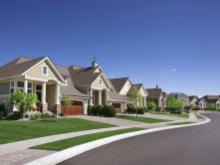Suburbia as an Ecological Challenge

In her essay in New Compass recent anthology Social Ecology and Social Change, Janet Biehl argues that it is possible to combine urban design that focuses on reducing suburban sprawl an lower carbon emission, with an infrastructure that strengthen our social bonds and foster community. Here is an excerpt from Biehl’s essay:
Far too much of the country’s built environment is auto-dependent: more than half the population live in sprawling suburbs, a landscape that requires every adult living in every household to have a car in order to function.
The social and ecological problems generated by sprawl are well known. Above all, suburban lifestyles are environmentally unsustainable: they spew higher emissions than urban ones, due to their dependency on the automobile for every trip outside the home. The single-family homes lack the energy efficiency of multiple unit buildings. And low-density settlement pattern renders suburbia unable to support public transit.
The long distances between destinations, and inadequate sidewalks, disqualify walking as a mode of transportation. Pedestrians who wish to cross an intersection on an arterial connecting enclaves risk their lives, darting across a yawning chasm in brief pauses in traffic. Schools are no longer an easily walk from home: back in 1969, about half (49 percent) of grade-school children walked or bicycled to school, but only 13 percent did in 2009. Parents now routinely drive children to play dates instead of letting them walk. In some suburbs children aren’t allowed to play on sidewalks. The result has been an epidemic of obesity—children today have a one in three chance of getting diabetes.
Video: Janet Biehl recommends Social Ecology and Social Change as the first real social ecology anthology with multiple authors. She also present her own essay in the book.
Governmental, cultural, and economic policy all preferred sprawling suburbia over older cities, whose street layouts dated to the pre-automobile age. But that preference resulted in neglect of those cities. Like any form of human settlement, city neighborhoods have to be maintained by programs of repair. But the FHA did not provide for reasonable loans for the renovation or upgrade of existing urban homes—such loans were small and of short duration, conducive only to minor repairs.The result was that old houses, buildings, and entire neighborhoods fell into neglect, then decay and deterioration.
Other urban cores were all but suffocated with pavement and concrete. Eager to lure auto-dependent suburbanites to come downtown, officials and their consultants welcomes even interstate highways into the urban core. They narrowed sidewalks and widened city streets and made them one way. They chopped down street trees, on the assumption that they were “fixed hazardous objects.” They demolished graceful historic buildings and on their sites built massive parking lots. “Between one third and one half of urban America’s land is typically dedicated to the driving and parking of vehicles,” reads one antisprawl manifesto. “In Los Angeles it’s two-thirds.”
In other places, public officials and private developers created new automobile-dependent cities that gave priority to cars and parking. Phoenix, Arizona, for example, lacks an urban core altogether—it has no pedestrian-scale downtown. In this classic Sun Belt city, “civic life has almost ceased to exist.”
Finally sprawling suburbia has had a negative impact on American democracy. By destroying public and civic spaces, it destroys community and sociability. In a traditional compact urban neighborhood, people stroll on sidewalks and in streets, they encounter their neighbors and pause to talk. Frequent street interactions gave rise to familiarity and friendliness and the attachments that are crucial for civic trust and civic engagement. “Lowly, unpurposeful, and random as they may appear,” wrote the great urban critic Jane Jacobs, “sidewalk contacts are the small change from which a city’s wealth of public life may grow.” Moreover, compact mixed-use neighborhoods have gathering places within walking distance of people’s homes and workplaces, like the local tavern or the corner store, where they can meet and talk on a regular basis.
But in sprawling suburbia these walkable public spaces are minimized or absent. And cars have the opposite effect: they cut us off from others, making us less sociable. As a person spends ever more time alone behind the wheel of car, he or she becomes “a self-sufficient nation of one,” observes one critic. The car “is everything a city is not.” As Jeff Speck and his coauthors observe, “As a motorist, you cannot get to know your neighbor, because the prevailing relationship is competitive. You are competing for asphalt. … The social contract is voided.”
Spending more time behind the wheel, people volunteer less, join clubs less, and participate in community projects less. According to the sociologist Robert Putnam, “Each ten additional minutes in daily commute time cuts involvement in community affairs by 10 percent— fewer public meetings attended, fewer committees chaired, fewer petitions signed, fewer church services attended, and so on.
The result is the destruction of the public realm. People retreat to their private home, where they interact with the rest of the world via television and computer. They are losing the ability to get along face to face, and even civil conversation is becoming rarer, a specialized art.
Buy Social Ecology and Social Change on Amazon. Soon also available in kindle and epub formats.